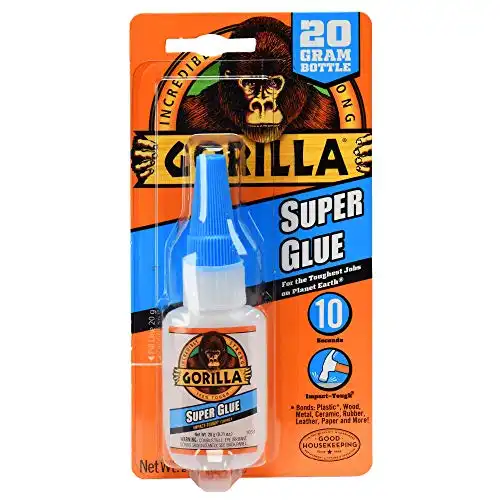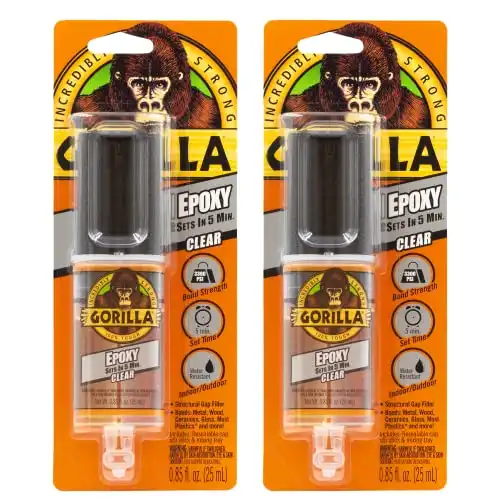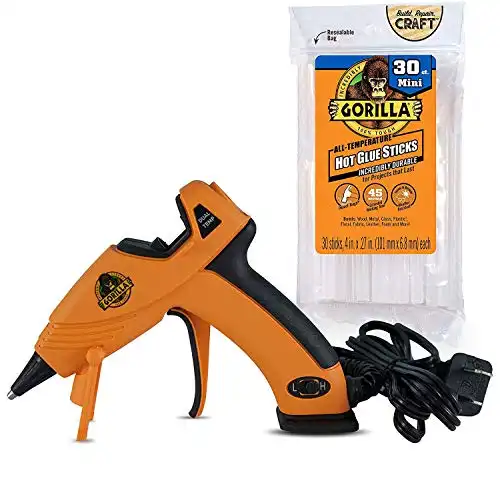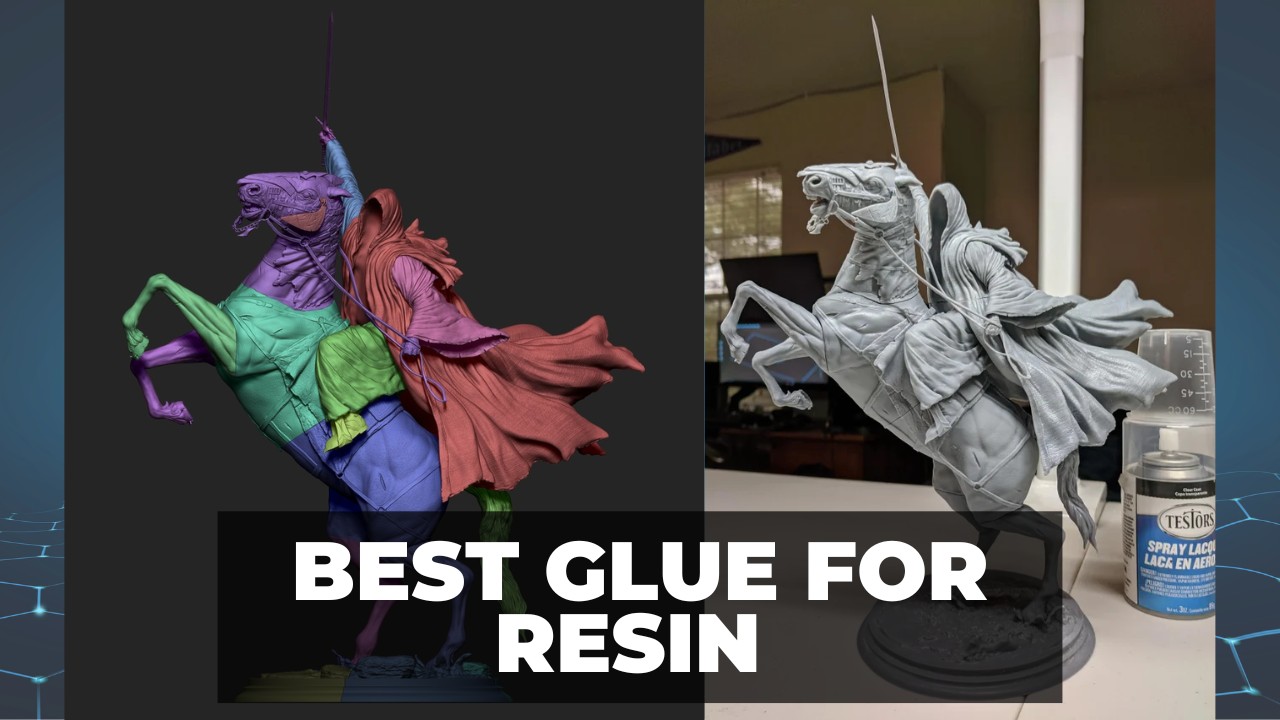
Hobbyist resin uses, as well as resin 3D printers, are becoming more and more popular every year. Very few machines can achieve the same level of fine detail and smooth surface finish of a resin printer – especially not FDM printers.
However, resin isn’t super strong: it’s brittle, snaps easily, and can break if dropped or handled roughly – especially if you’ve created fine resin details.
|
|
|
|
|
$7.98
|
|
$23.95
|
So, in this article we’ve ranked the best glues for resin 3D prints and poured resin models, so you can get the best results from your creations.
We also discuss the reasons you’d need to use resin glue, how to prep resin parts for gluing, how to glue resin miniatures, and the best glues for models such as Warhammer models.
Why You Might Need to Glue Resin
Printing in Multiple Pieces

Some things can’t print in a single piece. For example, a crafter making an intricate model train set may choose to glue a bench seat prop down to the train station platform.
3D printed models can elevate each other when put together carefully. In order to bring a complicated vision into reality, you will most likely have to use a touch of glue to bring everything together.
Fixing Broken Parts

The most common reason for needing to glue a broken piece of resin. Breaking pieces is almost inevitable if you work with enough resin.
It is not the strongest plastic material, and the pieces we love to make with resin often have small, fragile pieces on them. So, whether you 3D printed it yourself or purchased a resin model from a game store, don’t feel too bad about yourself if it snaps.
Replacing every broken model with a brand new one would be an expensive undertaking. Some pieces may have been difficult to get your hands on, or have taken a long time to 3D print. Whenever possible, it is always better to repair a broken piece than to buy a new one.
Set yourself up for success when mending broken resin pieces. Understand the ins and outs of gluing resin, and your broken model will be good as new.
What kinds of glue won’t work on resin?
First, it is important to understand which kinds of adhesives can’t be used on resin. Making a mistake and using the wrong kind of glue can make a bad situation worse, and might even ruin the part completely.
Plastic Cement and Plastic Glue
Products that claim to be “Plastic Glue”, or “Plastic Cement” are only formulated to bond polystyrene plastic. So, even though the resin is a type of plastic, it is not the kind of plastic that can be used with plastic glue or plastic cement.
These products work by dissolving a layer of plastic, then allowing the plastic to reharden when the pieces are pushed together. They can’t “melt” resin, so the bond will not stay.
Acetone
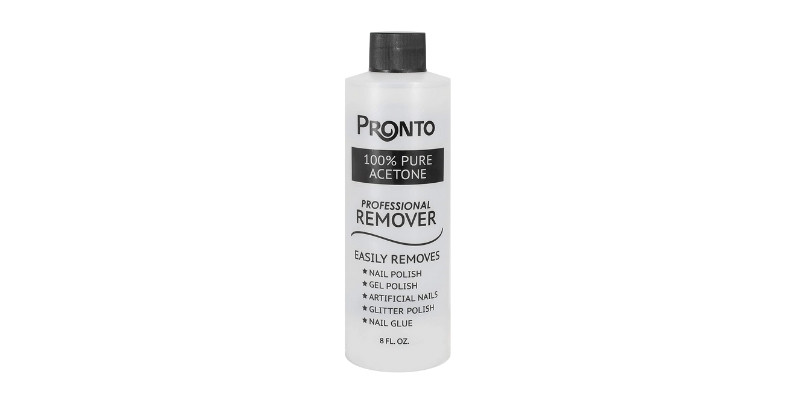
Acetone welding is a popular method to bond PLA and ABS plastic filaments. Similar to the plastic glue and plastic cement commercially available, acetone works as an adhesive by melting a layer of plastic.
Two pieces can then be joined together, and when they reharden they will stick. Acetone will not melt resin, so it can’t be used as a resin adhesive.
What kinds of glue will work on resin?
Two part epoxy, resin welding, super glue, and hot glue can all be used on resin surfaces. Even though you can’t use plastic glue, plastic cement, or acetone welding as adhesive on resin pieces, there are lots of kinds of glue that can be used.
You will need to carefully choose which kind of glue is right for your project based on the size of the piece you are gluing, what you want the seam to look like, and how you are going to hold the pieces while the glue sets and cures.
Best Glue for Resin
Super glue / Cyanoacrylate
Activator for cyanoacrylate (CA) super glue in a pump sprayer bottle (8 Ounce)
Pros
Readily available, cheap, and convenient.
Strong and sturdy.
Long lasting, even through wear and tear.
Cons
Hard to bond fiddly pieces together.
Super glue is the go-to adhesive for many people. It’s readily available, cheap, and convenient. It is the glue most people reach for when they are looking to fix broken pieces in a pinch.
Super glue works well on resin pieces. It’s strong and sturdy, so the bond lasts a long time, even through normal wear and tear.
Super glue works best when the bonding surfaces are held together with pressure until the glue fully sets. This can be hard to do if you are gluing small fiddly pieces. You probably can’t use a clamp to hold a broken sword blade onto the hilt. At least not if it is still attached to a figurine’s hand. Those spindly pieces are some of the most likely to break, so you have to find some way to make it work.
The best way to get around this problem is to use a super glue accelerator. These products are able to take the drying time of super glue down to almost zero. Instead of waiting several minutes for the super glue to begin to set, pair it with an accelerator for a hard bond in just a second or two.
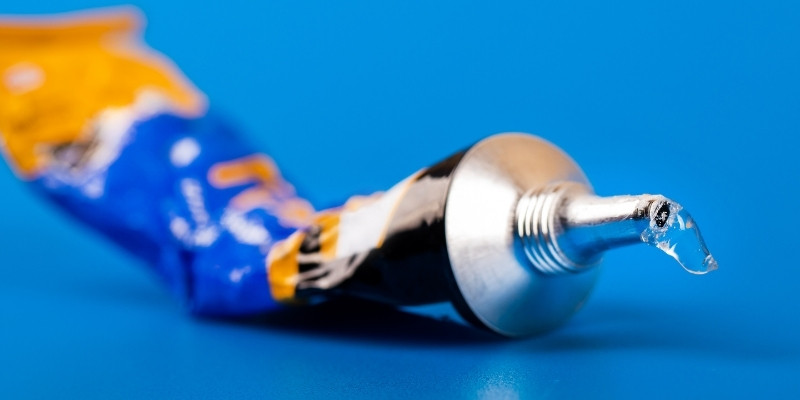
Price
$7.98 for a 20 g bottle of Gorilla Super Glue
$12.99 for 8 oz Starbond Instant Set Accelerator in a Pump Sprayer Bottle
Safety
Always use super glue in a well ventilated area.
Super glue dries very quickly, especially when used with an accelerator. Always wear gloves to make sure you don’t super glue your fingers together and protect your skin.
If you accidentally get super glue on your skin or another unintentional surface, buff it off with acetone nail polish remover and a cotton ball or clean cloth.
How to use
- Prepare all bonding surfaces by sanding and cleaning.
- Line up the surfaces before you begin.
- Apply a thin layer of super glue to one surface and a layer of the accelerator to the other.
- Press tightly together for one to three seconds before you release.
- Be confident and press the parts together correctly the first time. They will fuse together almost immediately, so a precise hand is important.
Epoxy
Sets in 5 Minutes, .85 Ounce Syringe, Clear, (Pack of 2)
Pros
Matches the texture of resin plastic very well.
Dries hard.
Can be used as a filler if you find any small holes.
Cons
Can be messy to work with.
Two part epoxy matches the texture of resin plastic very well. It dries hard, so there is a low risk of your parts breaking off from each other once the epoxy is set and cured.
It can be messy to work with and will leave a sticky residue if you accidentally get some on the wrong surface. It is great for places you need a hard bond, but don’t care about the look of the seam.
Epoxy isn’t just glue, it can also be used as a filler. If you find any small holes, seams, or imperfections on 3D printed parts that you don’t want to be there, epoxy can be applied with a paint brush to fill them in. It is also great for smoothing surfaces.
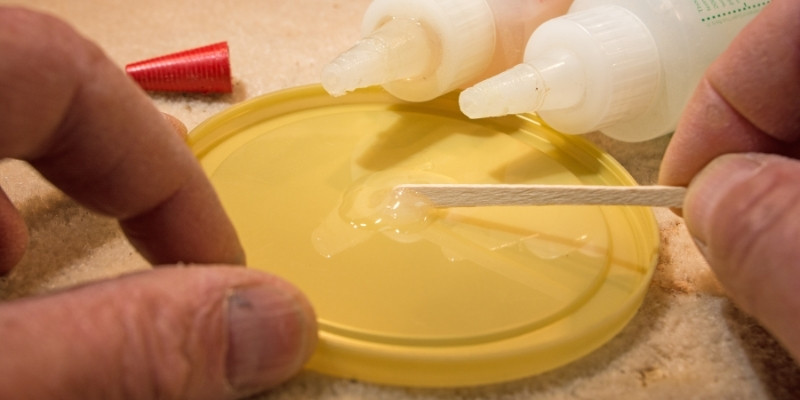
Price
$14.44 for Gorilla 2 Part Epoxy .85 Ounce Syringe Pack of 2
Safety
Epoxy is toxic and should not be breathed in. Proper ventilation is essential while working, but a good respirator is also a great idea. Gloves should be worn to protect the skin.
How To Use
- Epoxy can be tricky to use at first. There are two types of chemicals that need to be mixed at a specific ratio. First is the epoxy resin itself, then also a hardener that will trigger the chemical reaction that allows the epoxy to set. You need to get the proportions right, and once mixed, it needs to be used within a few minutes.
- Carefully read the directions that come with your epoxy resin to make sure that your bond is successful.
- To use epoxy as a resin adhesive, simply brush a thin layer onto one bonding surface. Press together.
- If possible, clamp for at least 30 minutes. Up to 24 hours for the full cure time.
Hot Glue Gun
Pros
Does a good job when gluing resin models down to a stable surface.
Common and easy to use.
Cons
Not the strongest bond on this list.
Hot glue guns are a common tool in any maker’s toolbox. While not the strongest bond on this list, hot glue can be a great choice in a pinch. If you are gluing resin models down to a stable surface, like trees or props onto a terrain surface, hot glue will do the job well. As long as the bond doesn’t need to withstand too much pressure, hot glue will be fine.

Price
$17.99 for Gorilla Dual Temp Mini Hot Glue Gun Kit with 30 Hot Glue Sticks
Safety
The nozzle of a hot glue gun gets very hot. Be careful not to touch the nozzle to avoid burns. Keep hot glue away from skin and clothing.
How To Use
- Prepare all bonding surfaces by sanding and cleaning.
- Heat up the hot glue gun.
- Apply a thick layer of glue to one bonding surface.
- Press the other surface to it.
- If possible, weigh pieces down or clamp until set.
Resin Welding
Pros
Gives the most seamless look possible.
Convenient, as you will already have the resin.
Cons
Toxic fumes.
Resin 3D printers work by depositing a thin layer of liquid resin from a vat, then curing each layer with UV light. If you 3D printed the original resin piece yourself, you can use the exact same resin to glue the pieces. This will give the most seamless look possible.
You can read more in our article on the best UV lights for curing resin models.

Price
If you use the original resin, the cost would be almost nothing. No additional purchases are necessary, and the amount of product you are using is very small.
Safety
Resin fumes are toxic. It can be a dangerous material to work with. Always work with resin in a well ventilated area, and wear a respirator. Wear gloves to protect your skin.
How To Use
- Apply a small amount of resin to the bonding surface with an eye dropper or a paint brush.
- Use a UV lamp, or prop up a small UV flashlight to cure the resin while you hold the pieces together.
Gluing Resin to Plastic
If you 3D print with multiple materials, you might run into a situation where you need to glue resin to another type of plastic – like PLA or PETG. This could also happen if you need to glue models together that you purchased separately.
Super glue is the best choice to join resin to other types of plastic. Using an accelerator is a good idea if the pieces are small or finicky. Be sure you give both pieces a quick sanding for some texture before you apply the glue – that will help give you the strongest possible bond.
How to prep resin pieces for gluing
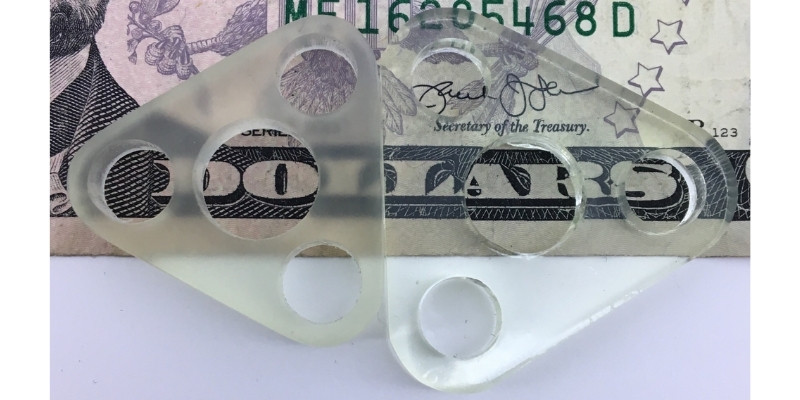
To ensure a successful bond, you will need to prep the resin bonding surfaces before you start gluing. Remember, some glues dry very quickly, so it’s important to be totally ready to go before you begin.
For pieces with enough surface area, the best way to prep the pieces is by giving them texture for the adhesive to stick to. Rough up the bonding surfaces with a bit of fine grit sand paper until you can see and feel a coarse texture. The little nooks and crannies in the resin will give the glue a place to hold on to. That will give you the strongest hold possible.
Some surfaces, like a broken sword blade, arm, or gun barrel, might be too small to sand. In that case, just skip it and move on to the next step.
Whether or not you are able to sand the bonding surface, it needs to be clean for the glue to be able to hold. Wipe the surface down with a damp cloth and a little bit of dish soap. You can also just use clean water. The important part is that the surfaces are free of any dirt, debris, or waste from the sanding process.
Other plastics can sometimes be wiped down with rubbing alcohol. Do not use rubbing alcohol on cured resin pieces. It will erode the plastic and could ruin the model entirely. Alcohol breaks down resin, so it should never be used on finished pieces. But is the best choice for cleaning up any resin messes or residue if you run into that problem.
How to glue resin miniatures

After the resin surfaces are properly prepared for bonding, the pieces can be glued. Each type of glue has a certain way it needs to be used. Always follow the instructions on the package. But there are a few general principles to consider when gluing resin.
No matter which product you choose, the resin glue needs to be applied to the surface, the pieces put together, and then they need to stay put while the glue sets. Sometimes this is simple – two large flat areas can easily be clamped until the glue is fully cured. But for more delicate pieces like miniature figurines, it can be complicated to find a way to keep the pieces together until the glue dries.
Always figure out how you are going to keep the pieces together before you apply the glue. Many figurines can be kept in place with a pin vise. You can also bend a paper clip to the shape you need to hold a small piece up. Whatever method you use, be sure to set it up before you start gluing.
Gluing Resin Miniatures
Since resin is ideal for small details, it is often the material chosen to make miniature figurines and terrain.
Tabletop games like Warhammer and Dungeons and Dragons have been popular among gaming enthusiasts for almost 40 years. Games like these often use miniature figures of soldiers, creatures, or characters. They also use prop items and terrain for the characters to interact with.
In the past, most players purchased these mini models from game stores. Now some players are turning to resin 3D printing to make their own figures at home. Making figures yourself gives you total control over the design and position of the figure. At a high enough scale of production, it is also less expensive than buying many figures individually.
|
|
|
|
|
$7.98
|
|
$23.95
|
Frequently Asked Questions
What glue is best for Warhammer?
Warhammer figurines can be glued together with super glue. Fixing broken pieces from a detailed Warhammer miniature figurine might be easier with a super glue accelerator. A super glue accelerator will be helpful if the pieces that need to be glued are small and spindly.
Can I use Gorilla Glue on miniatures?
Gorilla Glue can be used on miniatures. Mini figurines that are made with resin or other kinds of plastic and be glued together or repaired with Gorilla Glue, or any other kind of cyanoacrylate super glue. A super glue accelerator can also be used to help the glue dry quicker if the pieces are too small to be clamped together.
What is the best glue for miniatures?
The best glue for miniatures is cyanoacrylate super glue with a super glue accelerator. The cyanoacrylate is strong enough to bond plastic pieces of miniatures together. A super glue accelerator can help the glue dry quickly enough that the pieces don’t need to be clamped together.
Related articles:
- Best Glues For PETG 3D Prints For All Use Cases
- Best Glue For Bonding PLA, ABS, PETG, TPU, & Nylon 3D Prints
- Miniature 3D Printing: Resin vs FDM, Which is Best?
- How Many Models Can You 3D Print With 1L/500ml Resin? (With Calculations)
- Top of The Line Large Resin 3D Printers That Are Budget-Friendly
- Ranking The Best Wash and Cure & Resin Curing Stations
